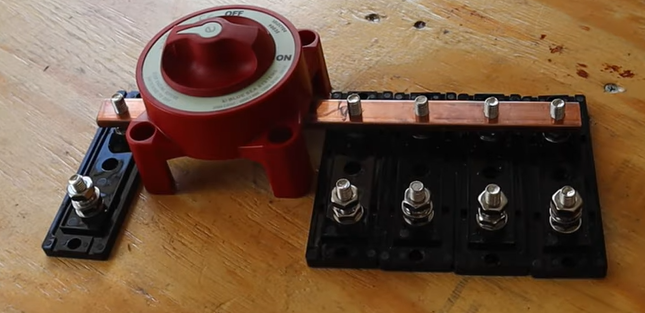While the Victron Energy Lynx busbar is highly regarded for its exceptional quality and seamless integration within Victron’s energy management ecosystem, its cost might be a concern for budget-conscious individuals.
For those seeking a more economical option without compromising on functionality, crafting a DIY busbar system presents an effective solution. This approach not only cuts down expenses but also offers the flexibility of customization to suit specific needs.
DIY Busbar System: A Cost-Effective Alternative
Using a DIY Copper Busbar
Copper, known for its excellent conductivity, is the material of choice for constructing a DIY busbar. You can easily find copper bars at local hardware stores or online platforms like Amazon. The key is to determine the correct current carrying capacity of the copper bar to ensure it meets your system’s requirements. For detailed guidance on this calculation, refer to my comprehensive article on DIY busbar creation.

The next step involves drilling holes in the copper busbar to accommodate your fuse holder posts. The size of these holes will depend on the post size, which could be M6, M8, or M10, based on your system’s specifications.
Fuse holders
Choosing appropriate fuse holders is crucial. The selection – whether ANL, MIDI, or MEGA fuses – should align with your system’s voltage and current specifications. For an in-depth understanding of how to select the right fuse sizes and types, check out my dedicated article on this topic.

Combining the busbar and the fuse terminals
The final assembly step is to attach the copper busbar to the fuse block. It’s important to place the fuse first, followed by the busbar on top. This ensures that the fuse is positioned horizontally, minimizing resistance. Incorrect placement can lead to inefficiencies in your system.

As demonstrated in the picture by Frugal Factor, there’s room for creativity in your DIY busbar system. You might consider incorporating a battery switch and a main system fuse for enhanced control and safety. However, it’s essential to ensure that the battery switch and the fuses are at the same height for a stable and secure installation.
Cost Comparison
At the time of writing, the Victron Lynx distributor costs $223.
Here are the costs for a similar system:
- Copper busbar rated for 450Amps: $18
- 4x MIDI fuse holder: $40
- Negative busbar: $19
Total cost of DIY lynx distributer: $77.
The price difference is $146.
Conclusion
Building your own DIY busbar system is not only a cost-effective alternative to purchasing a Victron Energy Lynx busbar but also allows for a tailored solution specific to your energy system’s needs. With careful planning, the right materials, and a bit of creativity, you can construct a reliable and efficient busbar system that meets your requirements.

I’m an off-grid enthusiast. I created this website to give clear and straight-to-the-point advice about solar power. I’m also the author of the book ‘Off-grid solar power simplified‘. Read more about me on my about page, check out my Youtube channel, or send me a message.